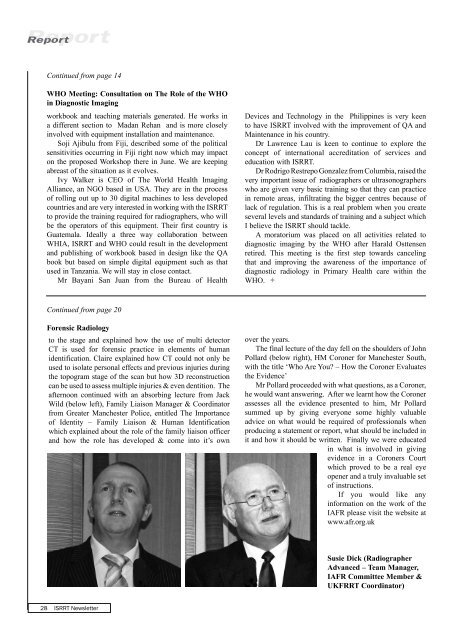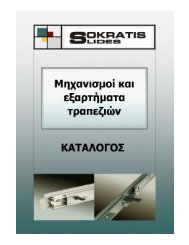isrrt Newsletter Volume 45. No.2 - 2009
Create successful ePaper yourself
Turn your PDF publications into a flip-book with our unique Google optimized e-Paper software.
Report<br />
Continued from page 14<br />
WHO Meeting: Consultation on The Role of the WHO<br />
in Diagnostic Imaging<br />
workbook and teaching materials generated. He works in<br />
a different section to Madan Rehan and is more closely<br />
involved with equipment installation and maintenance.<br />
Soji Ajibulu from Fiji, described some of the political<br />
sensitivities occurring in Fiji right now which may impact<br />
on the proposed Workshop there in June. We are keeping<br />
abreast of the situation as it evolves.<br />
Ivy Walker is CEO of The World Health Imaging<br />
Alliance, an NGO based in USA. They are in the process<br />
of rolling out up to 30 digital machines to less developed<br />
countries and are very interested in working with the ISRRT<br />
to provide the training required for radiographers, who will<br />
be the operators of this equipment. Their first country is<br />
Guatemala. Ideally a three way collaboration between<br />
WHIA, ISRRT and WHO could result in the development<br />
and publishing of workbook based in design like the QA<br />
book but based on simple digital equipment such as that<br />
used in Tanzania. We will stay in close contact.<br />
Mr Bayani San Juan from the Bureau of Health<br />
Devices and Technology in the Philippines is very keen<br />
to have ISRRT involved with the improvement of QA and<br />
Maintenance in his country.<br />
Dr Lawrence Lau is keen to continue to explore the<br />
concept of international accreditation of services and<br />
education with ISRRT.<br />
Dr Rodrigo Restrepo Gonzalez from Columbia, raised the<br />
very important issue of radiographers or ultrasonographers<br />
who are given very basic training so that they can practice<br />
in remote areas, infiltrating the bigger centres because of<br />
lack of regulation. This is a real problem when you create<br />
several levels and standards of training and a subject which<br />
I believe the ISRRT should tackle.<br />
A moratorium was placed on all activities related to<br />
diagnostic imaging by the WHO after Harald Osttensen<br />
retired. This meeting is the first step towards canceling<br />
that and improving the awareness of the importance of<br />
diagnostic radiology in Primary Health care within the<br />
WHO. <br />
Continued from page 20<br />
Forensic Radiology<br />
to the stage and explained how the use of multi detector<br />
CT is used for forensic practice in elements of human<br />
identification. Claire explained how CT could not only be<br />
used to isolate personal effects and previous injuries during<br />
the topogram stage of the scan but how 3D reconstruction<br />
can be used to assess multiple injuries & even dentition. The<br />
afternoon continued with an absorbing lecture from Jack<br />
Wild (below left), Family Liaison Manager & Coordinator<br />
from Greater Manchester Police, entitled The Importance<br />
of Identity – Family Liaison & Human Identification<br />
which explained about the role of the family liaison officer<br />
and how the role has developed & come into it’s own<br />
over the years.<br />
The final lecture of the day fell on the shoulders of John<br />
Pollard (below right), HM Coroner for Manchester South,<br />
with the title ‘Who Are You? – How the Coroner Evaluates<br />
the Evidence’<br />
Mr Pollard proceeded with what questions, as a Coroner,<br />
he would want answering. After we learnt how the Coroner<br />
assesses all the evidence presented to him, Mr Pollard<br />
summed up by giving everyone some highly valuable<br />
advice on what would be required of professionals when<br />
producing a statement or report, what should be included in<br />
it and how it should be written. Finally we were educated<br />
in what is involved in giving<br />
evidence in a Coroners Court<br />
which proved to be a real eye<br />
opener and a truly invaluable set<br />
of instructions.<br />
If you would like any<br />
information on the work of the<br />
IAFR please visit the website at<br />
www.afr.org.uk<br />
Susie Dick (Radiographer<br />
Advanced – Team Manager,<br />
IAFR Committee Member &<br />
UKFRRT Coordinator)<br />
28 ISRRT <strong>Newsletter</strong>

















